With Anand, Kramnik, Caruana, Nakamura, Gelfand, Adams, and dozens of other strong Grandmasters all signed up, the 2017 Isle of Man International was already shaping up to be one of the strongest open tournaments of all time, and that was before World Champion Magnus Carlsen decided to join the fray! In Carlsen’s own ironic words, he wanted to play after being “knocked out of the World Cup rather prematurely”. Of course, much of the top players' participation was dependent upon whether or not they were still in contention for the FIDE World Cup---so yes, I secretly rooted for all the top players to get knocked out quickly so that they'd surely play the Isle of Man!
While my own participation in this event was quite spontaneous last year, this year the trip was well thought out, and I was lucky to be joined by three fellow American chess players: GM Eugene Perelshteyn, IM Michael Brown, and IM Keaton Kiewra, my travel mate from last year. We booked an AirBnb about 10 minutes away from the playing venue, and every day we got to enjoy views of the sea as we walked to the event. We also heavily enjoyed the food on the island, often planning our dinners as much as we planned our openings for the day, if not more. This tournament was truly one of the most eventful that I've ever played---it seemed like every round there was some new story!
Those who followed the tournament probably heard about most of the drama, starting with the ‘random pairings’ used for the first round, then the continuation of Hou Yifan’s pairing controversy from the Gibraltar Masters, then the stunning upset of GM James Tarjan over Vladimir Kramnik! And of course while all this was happening, Magnus, seconded only by his new romance, was delivering an open tournament performance of a lifetime, clocking in at 2903!
My tournament progressed like a yoyo, one that's familiar to many class players, where you play way up then way down and so on and so forth -- in Round 1, I faced GM Falko Bindrich of Germany, losing the thread of the game in the middlegame and eventually going down in a difficult rook endgame. After a win in Round 2, I earned the chance to play another GM, and indeed in Round 3, I got paired with the legendary GM Ivan Sokolov! I had just spent 2 weeks watching him do the official commentary for the Tbilisi World Cup, so it was quite surreal to be in front of him at a chess board. Unfortunately, I lost the game rather quickly, but he was quite gracious when we discussed the game afterwards, so my mood was still mostly positive.
A win in Round 4 gave me another crack at a strong player in Round 5: IM Nihal Sarin, one of two currently exciting prodiges from India, the other being Praggnanandhaa Rameshbabu (or 'double Anand' for short, as famously dubbed by GM Simon Williams). I was quite happy to have won the game, but I could have easily spoiled it in the final moments:
[pgn][Event "Chess.com Isle of Man Masters"]
[Site "chess24.com"]
[Date "2017.09.27"]
[Round "5.40"]
[White "Kavutskiy, Kostya"]
[Black "Sarin, Nihal"]
[Result "1-0"]
[ECO "E20"]
[WhiteElo "2390"]
[BlackElo "2483"]
[Annotator "Kostya Kavutskiy"]
[SetUp "1"]
[FEN "8/8/5k2/p2P3b/2P5/2KN4/8/8 w - - 0 63"]
[PlyCount "19"]
[EventDate "2017.??.??"]
[SourceDate "2015.04.04"]
[WhiteTeam "United States"]
[BlackTeam "India"]
[WhiteTeamCountry "USA"]
[BlackTeamCountry "IND"]
[WhiteClock "1:40:30"]
[BlackClock "1:40:30"]{Through no one's bad technique but my own, we reached this difficult position
on the board, just after crossing the second time control. White is winning
thanks to the connected passers, but Black's a-pawn is oddly annoying, and of
course, Black is always looking for chances to give up the bishop for both
pawns.} 63. Kd4 $2 {Giving Black a chance to draw!} (63. c5 {was winning, but
White still has to be precise:} Bf7 64. Kc4 a4 65. c6 Ke7 66. Kc5 a3 67. d6+
Kd8 68. d7 Ke7 69. Ne5 $1 Be6 (69... a2 70. Nxf7 a1=Q 71. d8=Q+ Kxf7 72. Qd7+
Kf8 73. Kb6 $18 {and White is winning.}) 70. Ng6+ Kd8 71. Kd6 Bxd7 72. cxd7 a2
73. Ne7 a1=Q 74. Nc6# {A lovely variation.}) 63... a4 64. c5 a3 65. Nb4 Bd1 66.
c6 (66. Kc4 Ba4 67. c6 Bd1 $1 68. Kc5 Bf3 69. d6 Ke6 70. d7 Ke7 71. Kb6 Kd8 72.
Nd3 a2 73. Nc5 Bxc6 74. Kxc6 a1=Q 75. Nb7+ Ke7 76. d8=Q+ Kf7 $14) 66... Ke7 67.
Kc5 Kd8 $2 {An understandable move, but a losing one.} (67... Bg4 $3 {would
have saved the game for Black. 67...Bf3 and 67...Ke8 would have also led to a
Q+N vs. Q ending, which should be drawn.} 68. d6+ Kd8 69. Kb6 Kc8 70. Nd5 a2
71. d7+ Kd8 (71... Bxd7 $2 72. c7 $1) 72. Kb7 Bxd7 $1 (72... a1=Q {loses to}
73. c7+ Kxd7 74. c8=Q+ Kd6 75. Qc6+ $1 Ke5 76. Qf6+ {and Black loses the queen.
} Kxd5 77. Qxa1 $18) 73. c7+ Ke8 74. Nf6+ Ke7 75. Nxd7 a1=Q 76. c8=Q $11) 68.
Kb6 $1 {Now White is in time to promote-- the threat is c6-c7+ and Nc6-e7,
queening with checks before Black can promote.} Kc8 69. c7 $1 {Amazingly White
wins in study-like fashion.} Bg4 {The only defense.} 70. Nc6 Kd7 71. Ne5+ Kc8 {
Clever defense, 72.Nxg4 would actually lose after 72...a2!, but White has a
way to win.} (71... Ke7 72. Nxg4 a2 73. c8=Q {and White wins easily with the
d5-pawn still on the board!}) 72. Nc4 ({Black resigned in view of} 72. Nc4 Kd7
73. Nxa3 Kd6 74. Nc4+ Kxd5 75. Ne3+ $18) ({Also good was} 72. Kc6 a2 73. Nc4
Bd7+ 74. Kb6 {Threatening Nd6#.} Bh3 75. Nd6+ Kd7 76. c8=Q+ Kxd6 77. Qxh3 a1=Q
{and White only wins thanks to} 78. Qe6# $1) 1-0[/pgn]
Winning this game meant I had broken free of the proverbial 'yoyo' and, with +1 in such an event, was set to face an even stronger player. As it turned out, I ended up paired with none other than...Kramnik himself! Being the lowest rated player in my score group, I was paired "down" against the highest rated player with half a point less. It's pretty safe to say I was thrilled, floored even. Kramnik has been a personal idol for years, and an absolute legend in his own right. It was a definite honor to play against him.
I prepared my trusty King's Indian for the game (which was quite memorable all on its own) and was actually doing fine! Well, for a while:
[pgn][Event "Chess.com Isle of Man Masters"]
[Site "chess24.com"]
[Date "2017.09.28"]
[Round "6.31"]
[White "Kramnik, Vladimir"]
[Black "Kavutskiy, Kostya"]
[Result "1-0"]
[ECO "E60"]
[WhiteElo "2803"]
[BlackElo "2390"]
[Annotator "Kostya Kavutskiy"]
[PlyCount "91"]
[EventDate "2017.??.??"]
[SourceDate "2015.04.04"]
[WhiteTeam "Russia"]
[BlackTeam "United States"]
[WhiteTeamCountry "RUS"]
[BlackTeamCountry "USA"]
[WhiteClock "0:46:38"]
[BlackClock "0:58:09"]1. Nf3 Nf6 2. g3 g6 3. b3 {I polled my Facebook friends to try and guess what
Kramnik would play against the King's Indian. After all, he's a known King's
Indian slayer who can play basically anything here. A few correctly guessed
that he'd go for the double-fianchetto variation, bravo!} Bg7 4. Bb2 d6 5. d4
O-O $1 6. Bg2 c5 7. c4 {An interesting move, trying to gain as much space as
possible.} Ne4 {A seemingly strange but common idea, Black flings the knight
into the center to exchange it against White's undeveloped knight on b1. An
exchange of minor pieces usually helps Black here, as I have less space.} 8.
O-O Nc6 9. e3 e5 10. Ne1 ({The engine likes} 10. d5 Ne7 11. Nxe5 Nxf2 12. Rxf2
dxe5 {but I thought Black would be ok here with the knight coming to f5 and d6.
Alas, the strongest move according to Stockfish:} 13. g4 $1 $16 {and White has
a big strategic advantage.}) 10... f5 11. d5 Nb8 12. Bxe4 $5 {A commital move,
giving up the light-squared bishop, and White's only real chance to fight for
an advantage.} fxe4 13. Nc3 Bf5 {Kramnik spent about 25 minutes here. I cannot
claim to represent what he was thinking about in this time, but to me it was
clear he was not happy with his options at this point. What exactly did he
miss, or misevaluate, we'll never know!} 14. g4 $5 {This was a big surprise.} (
{Against} 14. Qc2 {I planned} Nd7 ({Stockfish points out} 14... a5 $3 {which I
didn't consider, and claims that Black has full compensation after} 15. Nxe4 a4
) 15. Nxe4 Nf6 ({During the game I thought} 15... Kh8 {was strong, with idea
Nf6, completely missing White's defense:} 16. Nf3 $1 Nf6 17. Nfd2 $14 {and
Black does not have enough, so I'd have to try b5 here or something.}) (15...
Qe7 $5 {is also interesting}) 16. Nxf6+ Qxf6 {I thought Black would have some
compensation here, due to the eventual pressure on the light-squares and
f-file.} 17. Qe2 Bh3 18. Ng2 Qf3 19. Qxf3 Rxf3 20. e4 Raf8 21. Bc1 $14) 14...
Qg5 15. h4 {I sensed this was White's idea (I mean what else?) but I almost
couldn't believe my eyes at the board, and for a brief second I thought I
might checkmate Vladimir Kramnik in this game.} Qxg4+ {Forced.} ({Of course,
my first instinct was to go for the attack with} 15... Qxh4 {but White's
knights arrive to the defense in time after} 16. gxf5 Rxf5 17. Ng2 Qh3 18. Nxe4
Rh5 19. f3 $18 {and Black is out of threats.}) 16. Qxg4 Bxg4 17. Nxe4 {I felt
that Black should have very few problems in this endgame, but maybe that was
optimistic. Here I spent some time deciding on whether I should grab the
exchange or not.} Be2 {I believe I made the wrong decision here. During the
game I realized Rd8 might be a better move practically, to keep the strong
light-squared bishop, but I thought that Be2 was objectively stronger, so I
went with that. But that was probably an error due to the fact that I was
playing a legend. Against a different player, I would most likely just play
Rd8 and accept a pleasant endgame.} ({After the simple} 17... Rd8 18. f3 Bf5 {
I feel Black is not worse here, due to the power of the unopposed light
squared bishop. A follow-up plan is to play Na6-c7 and prepare b7-b5.}) 18.
Nxd6 Bxf1 $2 {This was a serious mistake. I confused myself, because my first
thought was to leave the bishop on e2 and force White to spend a tempo to
force me to take the rook. But during the game I thought I would get some
immediate play against the king on f1, but this was not based on anything
concrete.} ({Better was} 18... b6) ({Or even} 18... Nd7 $1 {since} 19. Nxb7 Rf6
20. Na5 Raf8 21. Ng2 Bxf1 22. Rxf1 Ra6 $1 23. Bc3 Rf7 $11 {and it seems like
Black is OK.}) 19. Kxf1 b6 20. Ke2 Nd7 21. Nd3 $1 {Here White has achieved his
ideal setup and has a clear advantage. Despite the small material deficit, all
of White's pieces are strong and Black has no counterplay. Interestingly
enough, I lost to Shirov in the 2016 Isle of Man International in a similar
fashion, being up an exchange in a worse endgame!} Rad8 22. Ne4 Rde8 23. Rg1
Nf6 24. Ng5 {During the game I thought I was more or less fine here, but I
blundered into a lost position -} Nxd5 $2 ({My best chance was} 24... e4 25.
Nf4 Nxd5 $1 26. cxd5 Bxb2 27. Nfe6 Rf6 {and Black continues to fight.}) 25.
cxd5 e4 26. Nxc5 $1 {Missed this one.} ({I only counted on} 26. Bxg7 exd3+ 27.
Kxd3 Kxg7 28. Ne6+ Rxe6 29. dxe6 Rxf2 $15) ({Or} 26. Nf4 Bxb2 27. Nfe6 Rf5 $14
{where Black is surviving for the moment.}) 26... bxc5 27. Bxg7 Kxg7 28. Ne6+
Rxe6 29. dxe6 {The big difference here is that Black has several weaknesses,
and White's extra pawn on e6 still needs to be taken. All in all White is very
close to just winning here.} Kf6 30. Rg4 Ke5 {I felt it was best to activate
the king as much as possible.} 31. Rf4 $1 {A very precise move, activating
White's rook.} (31. Rg5+ Kd6 32. h5 Rf5 $1 $16 {is not so clear.}) 31... Re8 (
31... Rxf4 $2 32. e7 $1 $18 {is the point.}) 32. Rf7 h5 33. Rxa7 Kxe6 (33...
Rxe6 34. Ra5 $18 {followed by b3-b4, winning.}) 34. Ra6+ Kf5 {My only chance
is to create a passer with my h-pawn, but as it turns out in the game this is
too slow. White wins with good technique, as Kramnik had no problems showing!}
35. Rc6 Kg4 36. Rxc5 (36. Rxg6+ Kxh4 37. a4 Rb8 38. Re6 $1 $18 {was also good.}
) 36... Kxh4 37. a4 Kg4 38. a5 h4 39. Rc6 g5 (39... h3 {was a better try but
should be losing:} 40. Kf1 $1 $18 {and Black just cannot get enough
counterplay with the h-pawn, while White's queenside passers are decisive.})
40. a6 {The only winning move!} (40. Rh6 $2 {would run into} Rb8 $1 41. Rb6 Rh8
$1 42. Kf1 h3 43. Kg1 h2+ 44. Kh1 Rf8 45. Kxh2 Rxf2+ 46. Kg1 Kg3 $11 {and
Black has enough counterplay to hold.}) 40... h3 41. Kf1 $1 Rd8 42. Kg1 Rd2 43.
Rf6 $1 {Killing all counterplay, White is easily winning now.} Ra2 44. b4 Ra4
45. b5 Ra5 46. Rf8 {Honestly. it was a bit of an honor to get ground down in an
endgame against Kramnik!} 1-0[/pgn]
I wasn't upset about the loss at all as I learned a great deal, but it was a bit disappointing that he left quickly after the game. All in all, still the highlight of my trip! I bounced back quickly with a clean win over IM Martin Zumsande of Germany, which got me paired with GM Rasmus Svane (another German!) in Round 8. I prepared well for the game, but tried a little too hard to win in a drawn endgame and ended up blundering and losing. This was definitely a shame, as another half-point would have secured a fantastic tournament. In Round 9, I ended up losing again, this time to IM Aman Hambleton of Canada. And I wasn’t too upset about this one either, as it was an especially complicated game which could have gone any number of ways.
Thus, I finished my tournament with just 4/9, gaining just a few rating points. Overall, I felt fantastic about the experience, I got to play so many strong players and learned a great deal from all of my encounters.
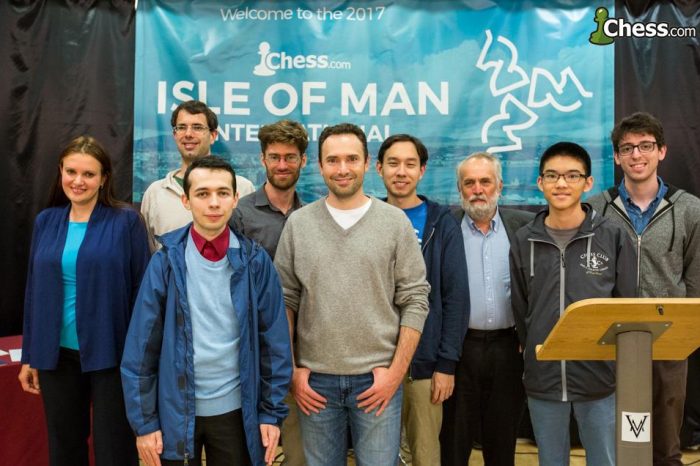 The American contingent at the Isle of Man Open (left to right): Anna Zatonskih, Keaton Kiewra, Aleksandr Lenderman, Marc Esserman, Eugene Perelshteyn, Michael Brown, James Tarjan, Jeffrey Xiong, Kostya Kavutskiy (not pictured: Fabiano Caruana, Hikaru Nakamura, Varuzhan Akobian, Christopher Yoo). Photo: Chess.com / Maria Emilianova
The American contingent at the Isle of Man Open (left to right): Anna Zatonskih, Keaton Kiewra, Aleksandr Lenderman, Marc Esserman, Eugene Perelshteyn, Michael Brown, James Tarjan, Jeffrey Xiong, Kostya Kavutskiy (not pictured: Fabiano Caruana, Hikaru Nakamura, Varuzhan Akobian, Christopher Yoo). Photo: Chess.com / Maria Emilianova
Of course, my travel mates also had quite compelling tournament experiences. The excitement started in Round 2, as Keaton got paired with GM Sergei Movsesian and Eugene got paired with the one and only Magnus Carlsen!
First, Keaton put in a lot of effort and began ‘sacking the house’ against his esteemed GM opponent. In mutual time trouble, he missed a few powerful continuations and ended up losing in an endgame:
[pgn][Event "Chess.com Isle of Man Masters"]
[Site "Douglas ENG"]
[Date "2017.09.24"]
[Round "2.36"]
[White "Kiewra, Keaton"]
[Black "Movsesian, Sergei"]
[Result "0-1"]
[ECO "B45"]
[WhiteElo "2433"]
[BlackElo "2671"]
[Annotator "Kostya Kavutskiy"]
[PlyCount "86"]
[EventDate "2017.09.23"]
[EventRounds "9"]
[EventCountry "ENG"]
[Source "Mark Crowther"]
[SourceDate "2017.09.25"]1. e4 c5 2. Nf3 e6 3. d4 cxd4 4. Nxd4 Nc6 5. Nc3 d6 6. Be3 a6 7. Be2 Bd7 8. a4
Nf6 9. O-O Be7 10. Kh1 O-O 11. f4 Qc7 12. Qe1 Nb4 13. Qg3 Rfc8 14. e5 Nfd5 15.
Nxd5 Nxd5 16. Bg1 Be8 17. c3 dxe5 18. fxe5 Nb6 19. Bg4 Nd7 20. Be3 Nf8 21. h4
Ng6 22. h5 Qxe5 23. Qh3 Nf8 24. Rae1 Qd5 25. Bd1 h6 26. Bb3 Qd7 27. Bxh6 $5 {
A very daring sacrifice. At this point, the players were approaching heavy
time trouble, meaning all three results would be possible for the next dozen
moves!} gxh6 28. Nxe6 $1 {A powerful follow-up, putting Black in great danger,
as the rook on a8 cannot contribute to the defense.} Bg5 (28... Nxe6 29. Rxe6
Rc5 $1 {And only Rc5 would fend off White's attack, with idea to put the rook
on g5. Otherwise White's pieces would break through.}) (28... fxe6 29. Rxe6 $1
{is absolutely crushing for White.} Bf7 30. Rg6+ $1 Nxg6 31. Bxf7+ Kh8 32. Qxd7
$18) 29. Nxg5 hxg5 30. Qf3 {Threatening Qf6, followed by Rxe8 and Bxf7+. White
has a serious attack here as all of his pieces are working in coordination,
including the h5-pawn!} Nh7 $1 {The only move.} 31. Re5 Rc7 (31... Kh8 $1 $11 {
was apparently the only move to not allow a winning continuation. A logical
move, but these variations are usually not based so much on logic but rather
on concrete lines. And good luck figuring all this out at the board, with very
limited time!}) 32. Qe4 (32. Qg3 $1 {Threatening to take on g5, was very
strong.} Rc6 33. Rxg5+ Nxg5 34. Qxg5+ Kh8 35. Rf6 $1 $18 {and White willl soon
give mate, or win the queen.}) 32... Qc6 ({Again} 32... Kh8 $1 {was best,
where White has enough compensation to hold the balance.}) 33. Bd5 Qxa4 34. c4
$1 {A very strong move, heavily restricting Black's queen on a4. At this point
the players were more or less playing on 30-second increment.} Rd8 35. Re1 (35.
h6 $1 {was winning, threatening Qg6+ and Qg7#.} Kh8 {And now} 36. b3 $3 {Not
the only winning move, but definitely the most stunning.} ({In case of the
immediate} 36. Rxg5 Nxg5 37. Qd4+ f6 38. Rxf6 Rxd5 $3 $19 {and amazingly White
has no mate here.}) 36... Qd7 37. Rxg5 Nxg5 38. Qd4+ f6 39. Rxf6 $18 {and
White is mating by force.}) 35... Kg7 36. Rxe8 $6 {This gives up White's
attacking chances and goes into an equalish endgame, an understandable
decision in time-trouble.} (36. Qd4 $1 {would give White excellent chances
after the following forced line:} f6 37. Re7+ Rxe7 38. Rxe7+ Kh6 39. Rxh7+ $1
Kxh7 40. Be4+ Kg7 41. h6+ $1 Kxh6 42. Qxf6+ Kh5 43. Qxd8 $18) 36... Qxe8 37.
Qxe8 Rxe8 38. Rxe8 Nf6 39. Re5 $2 {Essentially the losing move, which
unfortunately came right before the time control.} (39. Rb8 $1 $11 {was the
only move to keep things approximately level.}) 39... Kh6 40. Rf5 Nxd5 41. cxd5
Kxh5 {Now Black has won a pawn and will soon win a second, as White's rook is
awkwardly placed.} 42. d6 Rd7 43. Rf6 g4 {And White resigned in view of Kg5
next.} 0-1[/pgn]
Meanwhile, Eugene was well focused for his big game against the World Champion, and really took it to Magnus, playing for the initiative right from the start. I think this was absolutely the right approach, as Magnus is unstoppable when given the type of position he likes, with small strategic advantages that he can use to grind and grind and grind. The only way to have a chance is to truly sharpen things up!
[pgn][Event "Chess.com Isle of Man Masters"]
[Site "Douglas ENG"]
[Date "2017.09.24"]
[Round "2.1"]
[White "Perelshteyn, Eugene"]
[Black "Carlsen, Magnus"]
[Result "0-1"]
[ECO "B06"]
[WhiteElo "2524"]
[BlackElo "2827"]
[Annotator "Kostya Kavutskiy"]
[PlyCount "98"]
[EventDate "2017.09.23"]
[EventRounds "9"]
[EventCountry "ENG"]
[Source "Mark Crowther"]
[SourceDate "2017.09.25"]1. d4 g6 2. e4 d6 3. Nc3 Bg7 4. Be3 a6 5. Nf3 b5 6. Bd3 Nd7 7. e5 Bb7 8. e6 $1
{A thematic pawn sacrifice to ruin Black's structure.} fxe6 9. Ng5 Nf8 10. O-O
Qd7 11. Re1 Nf6 12. a4 $5 ({After the game Eugene mentioned that they had been
following a high-level game between Anand & Svidler, and that Carlsen likely
knew this game. Indeed, but the game was from 1998!} 12. Bd2 h6 13. Nf3 Rb8 14.
a4 b4 15. Ne4 Nxe4 16. Bxe4 Bxe4 17. Rxe4 {and White eventually won a
complicated game, Anand - Svidler, Linares 1998.}) 12... b4 13. Na2 Qxa4 {
Carlsen is very daring to accept the second pawn.} 14. Qe2 h6 (14... c5 $1 $11
{holds the balance, according to Stockfish, with idea} 15. dxc5 Qc6 $1 $132 {
with counterplay.}) 15. Nf3 Kf7 16. Bd2 b3 17. Nc3 (17. Nb4 $1 Qd7 18. cxb3 $16
{would have given White a bigger advantage, immediately going after the
a6-pawn.}) 17... Qd7 18. cxb3 Rb8 19. Ra3 Nd5 20. Ne4 Kg8 21. h4 Qe8 22. Bxa6
Bxa6 23. Qxa6 Bf6 24. Qc4 Nd7 25. Nc3 N7b6 26. Qe2 Qf7 27. Ne4 Rf8 {The
critical position. It is clear that White is better--he controls more space
and his pieces have more freedom. But Black is super solid, and it's near
impossible for White to even create a threat! If White repositions his forces
to break through on the queenside, a timely g6-g5 would give Black serious
counterplay. Not seeing a clear way forward, Eugene opted for simplifications
with} 28. Nxf6+ $6 ({Instead, something like} 28. b4 $14 {, asking Black to
make a move would be better. With best play, White will be playing for two
results, so it would be up to Magnus to see how much risk he'd be willing to
take in order to play for a win here as Black.}) 28... exf6 29. Qxe6 Qxe6 30.
Rxe6 {White has won a pawn but given up his entire advantage, as Black's
knights create a powerful blockade. Although the engine evaluates this as
equal, Black's position proves easier to play and Carlsen plays like a machine
(if not stronger) to end up earning the full point. A real endgame masterclass:
} Kf7 31. Re1 Rb8 32. Rc1 Nc8 33. Ne1 Nce7 34. Nd3 g5 35. hxg5 hxg5 36. b4 Rh4
37. Bc3 Rbh8 38. g3 Rh1+ 39. Kg2 R8h2+ 40. Kf3 g4+ 41. Kxg4 Rxc1 42. Nxc1 Rxf2
43. Be1 f5+ 44. Kh3 Rxb2 45. Nd3 Rc2 46. b5 Nf6 47. Rb3 Re2 48. b6 cxb6 49.
Rxb6 Ne4 {And White resigned due to the unstoppable threat of Ng5+ & Nf3+,
either winning a piece or delivering mate with Rh2.} 0-1[/pgn]
Last but not least, Michael was having the tournament of his life, hanging in there with GMs left and right. It all came down to the final round, as he needed to defeat legendary Hungarian GM Zoltan Almasi to earn his second GM norm. The end of this game was one of the most exciting that I’ve witnessed personally:
[pgn][Event "Chess.com Isle of Man Masters"]
[Site "?"]
[Date "2017.10.01"]
[Round "9"]
[White "Brown, Michael"]
[Black "Almasi, Zoltan"]
[Result "1-0"]
[ECO "A50"]
[WhiteElo "2499"]
[BlackElo "2707"]
[Annotator "IM Michael Brown"]
[PlyCount "147"]
[EventDate "2017.??.??"]1. d4 e6 2. c4 b6 3. Nc3 Bb7 4. a3 Nf6 5. d5 Bc5 6. Nf3 a5 7. g3 exd5 8. cxd5
Ng4 9. e3 Nf6 10. Bg2 Ba6 11. Rb1 Qe7 12. Nd4 Bxd4 13. Qxd4 c5 14. Qa4 Qd8 15.
Nb5 O-O 16. O-O d6 17. Rd1 Qd7 18. Bf1 Ne8 19. Qc4 a4 20. b3 axb3 21. Qxb3 Qe7
22. Bb2 Nd7 23. a4 Nef6 24. Bg2 Rfc8 25. Rbc1 Ne5 26. Qc2 Bxb5 27. axb5 Qe8 28.
Qf5 Rd8 29. Rb1 Ra2 30. h3 h6 31. g4 Qe7 32. Bc3 Ra3 33. Bb2 Rb3 34. Ba1 Rxb1
35. Rxb1 Ra8 36. Bc3 g6 37. Qc2 h5 38. g5 Nfd7 39. h4 Kh7 40. Ra1 Rxa1+ 41.
Bxa1 f6 42. f4 Ng4 43. e4 Qf8 44. gxf6 Qa8 45. Bc3 Ndxf6 46. Qb2 $6 {Imprecise.
Moving the bishop to f3 first was the better option.} (46. Bf3 {and now if
Black plays like he did in the game with} Qd8 (46... Qa3 47. Qb2 Qxb2 48. Bxb2
Kg8 {is perhaps Black's best chance, but White is always pushing here.}) 47.
Qe2 {and I am up a tempo compared to the game}) 46... Qd8 $1 {Almasi equalizes.
Now the game is just equal since I can't create threats against his king.} 47.
Bf3 Ne8 48. Be1 Qe7 49. Qe2 Qf6 50. Kg2 {I was very happy to find this move.
Otherwise, my position may even be worse:} (50. Bg3 Qd4+ 51. Kg2 Nef6 {and I
am just paralyzed}) 50... Qd4 {By this point, Almasi's pieces have become
quite active and it's become more double-edged. I decided my best chance was
to try to get rid of one of his active pieces here with} 51. Bf2 Nxf2 52. Qxf2
Qc3 53. Qe2 {Threatening to take on h5. But here Almasi played the very
double-edged} Qd4 $5 {Goading me to take the pawn! However, he has a lot of
counterplay with his c-pawn.} 54. Bxh5 Nf6 (54... c4 {may even be a tiny bit
better for Black, though after} 55. Bf3 c3 56. h5 gxh5 57. Bxh5 Nf6 58. Bf3 $13
{Indeed the pawn on c3 is dangerous, but Black's king is completely open.}) (
54... gxh5 55. Qxh5+ Kg7 56. Qxe8 $18) 55. Bf3 c4 56. Qf2 {Offering a trade of
queens which Almasi must refuse, since the ensuing minor piece endgame wil be
lost. But now my queen invades.} Qd3 57. Qxb6 $1 {My best chance. I start to
take everything in Black's camp.} c3 58. Qc7+ Kh6 59. Qxd6 c2 $2 {The final
mistake. Almasi probably realized that his position has actually become dire,
but unwilling to force a perpetual, he tries to go for the win instead!
However, this turns out badly; I already have a perpetual myself in this
position, and can also go for more, which I did.} (59... Qd2+ 60. Kh3 Qf2 {was
absolutely necessary; I have nothing better than to give a perpetual.}) 60.
Qxf6 $1 {And the mate threat on h8 stops Black from queening. I am now winning!
} Qd2+ 61. Kh3 Kh7 62. h5 $1 {Tearing open Black's king. The combined threats
on his king and my extra piece keep Black from being able to promote.} gxh5 (
62... c1=Q {This loses to a nice mate:} 63. hxg6+ Kh6 64. Qh8+ Kxg6 65. Bh5# {
A picturesque finish; Black is completely helpless to stop mate despite his
two queens.}) 63. Qf7+ Kh8 64. Qf8+ Kh7 65. Qf7+ Kh8 66. Qxh5+ Kg7 67. Qe5+ Kh7
68. Qe7+ (68. Bg4 {is more precise, but there were many ways to win in this
position.}) 68... Kg8 69. Qd8+ Kg7 70. Qc7+ {I decided to put my queen on c7
to stop any queening ideas for my opponent.} Kh8 71. Bh5 {My bishop joins the
attack. Black still can't queen, and in order to stop mate, he has to give up
the potential of queening his pawn, thus forcing the game to end.} Qe3+ (71...
c1=Q 72. Qd8+ Kg7 73. Qe7+ Kg8 74. Bf7+ Kg7 75. Be6+ Kh6 76. Qf8+ Kg6 77. Bf5+
Kh5 78. Qh8#) 72. Kh4 Qxe4 {Black wins a couple of my pawns, but now my king
can march in, and Black is helpless to stop it.} 73. Kg5 Qxd5+ 74. Kh6 {and
here Black capitulated. There are simply too many threats on his king, and no
perpetual or stalemate tricks to save him. What a way to finish the tournament!
} (74. Kh6 Qe6+ 75. Bg6 Qh3+ 76. Kg5 Qg3+ 77. Kf6 Qh4+ 78. Kf7 {and fresh out
of checks, Black will be mated shortly.}) 1-0[/pgn]
While our group did not perform as successfully as we would have liked, it was amazing to see Michael crush it and earn a GM norm! To sum up, the tournament’s conditions overall were simply superb. I can’t remember once as a player being dissatisfied with the tournament hall, the organization, and so on. I’d definitely like to thank Alan Ormsby, Chess.com, the main sponsor Isai Scheinberg, and the rest of the staff who put so much effort into making this tournament truly incredible. I’m very much looking forward to next year already!
About the Author
Kostya Kavutskiy is a professional chess player, coach, and author currently residing in Mountain View, CA. His first book,
Modernized: The Open Sicilian, was published in February 2015. For more of Kostya, check out his official
Twitter and
Facebook.
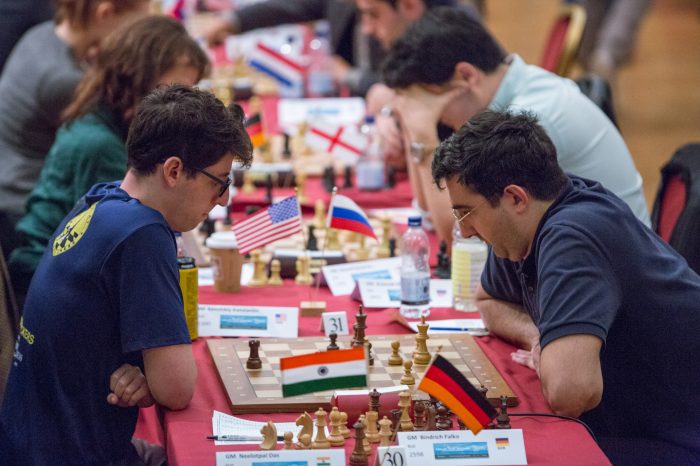 IM Kostya Kavutskiy vs. the 14th World Champion, Vladimir Kramnik. Photo: Chess.com / Maria Emilianova
IM Kostya Kavutskiy vs. the 14th World Champion, Vladimir Kramnik. Photo: Chess.com / Maria Emilianova The American contingent at the Isle of Man Open (left to right): Anna Zatonskih, Keaton Kiewra, Aleksandr Lenderman, Marc Esserman, Eugene Perelshteyn, Michael Brown, James Tarjan, Jeffrey Xiong, Kostya Kavutskiy (not pictured: Fabiano Caruana, Hikaru Nakamura, Varuzhan Akobian, Christopher Yoo). Photo: Chess.com / Maria Emilianova
The American contingent at the Isle of Man Open (left to right): Anna Zatonskih, Keaton Kiewra, Aleksandr Lenderman, Marc Esserman, Eugene Perelshteyn, Michael Brown, James Tarjan, Jeffrey Xiong, Kostya Kavutskiy (not pictured: Fabiano Caruana, Hikaru Nakamura, Varuzhan Akobian, Christopher Yoo). Photo: Chess.com / Maria Emilianova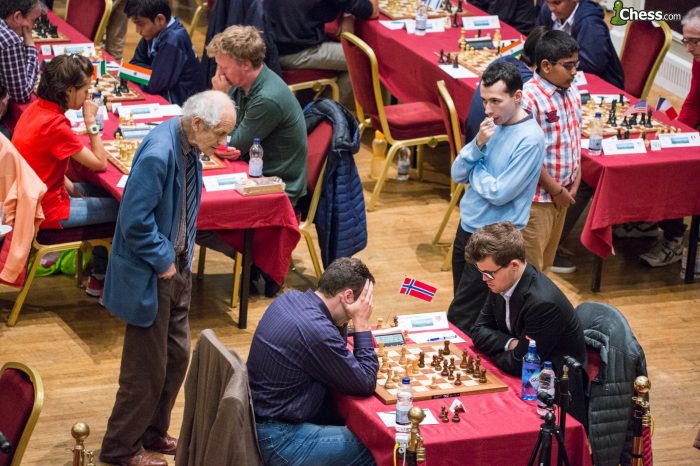 Eugene Perelshteyn vs. Magnus Carlsen. Photo: Chess.com / Maria Emelianova
Eugene Perelshteyn vs. Magnus Carlsen. Photo: Chess.com / Maria Emelianova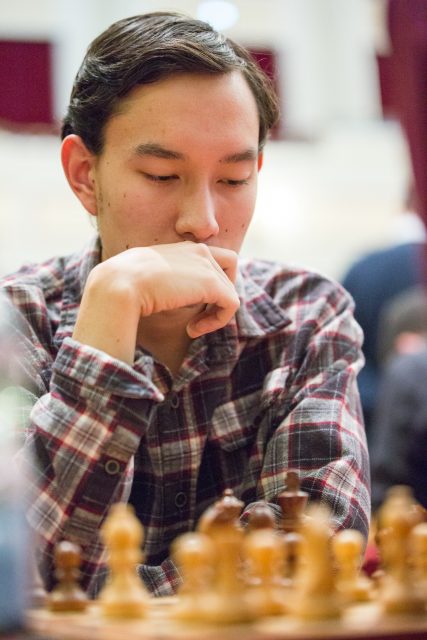 IM Michael Brown. Photo: Chess.com / Maria Emelianova
IM Michael Brown. Photo: Chess.com / Maria Emelianova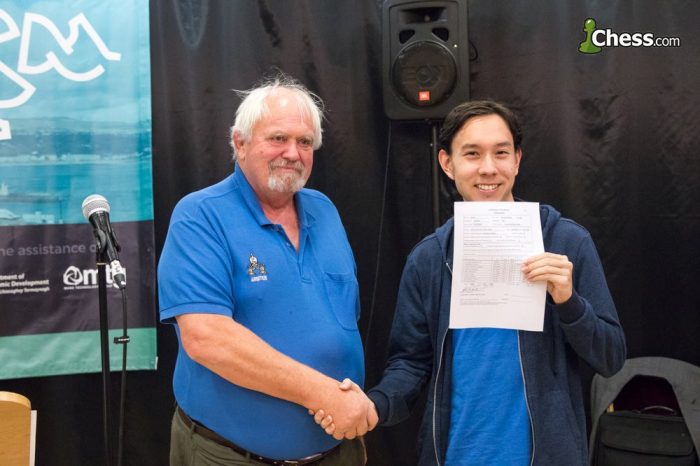 IM Michael Brown receiving his 2nd GM Norm. Photo: Chess.com / Maria Emelianova
IM Michael Brown receiving his 2nd GM Norm. Photo: Chess.com / Maria Emelianova






